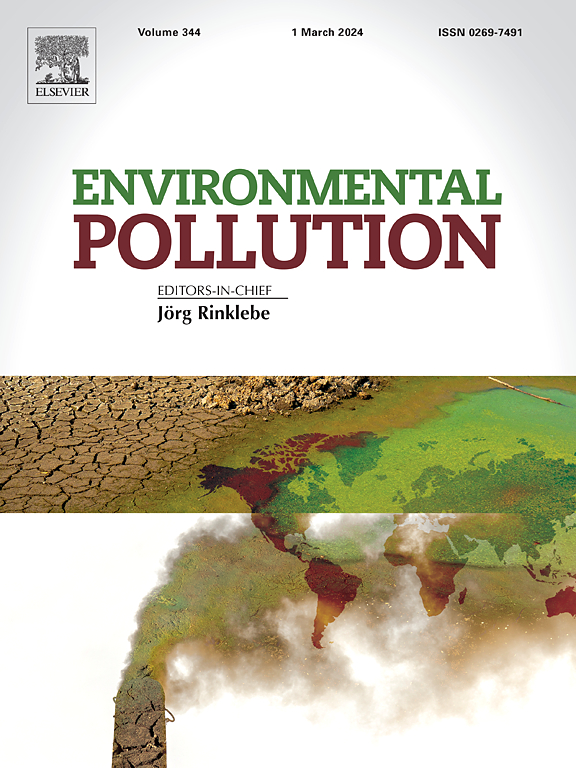Enantioselectivity in human urinary excretion of N-(1,3-dimethylbutyl)-N’-phenyl-1,4-benzenediamine (6PPD) and 6PPD-quinone
IF 7.6
2区 环境科学与生态学
Q1 ENVIRONMENTAL SCIENCES
引用次数: 0
Abstract
Human exposure to of N-(1,3-dimethylbutyl)-N′-phenyl-1,4-benzenediamine (6PPD) has raised global concerns due to its documented toxic effects, including hepatotoxicity, metabolic disruption, and potential contributions to organ damage. 6PPD-quinone (6PPD-Q), a ubiquitous transformation product of 6PPD, has been identified as a major toxicant linked to acute mortality in aquatic species, underscoring its ecological and human health risks. While these compounds exist as enantiomers with demonstrated differences in environmental behavior and toxicity, their enantiomer-specific distribution and excretion patterns in humans remain unknown limiting accurate risk assessments. This study analyzed 6PPD and 6PPD-Q in 109 pairs of whole blood and urine from general Chinese adults at the enantiomer-specific level. Results showed that 6PPD (range < LOD–0.60 ng/mL) and 6PPD-Q (<LOD–0.74 ng/mL) were detected in 39 % and 43 % of human whole blood samples, respectively. Calculated mean enantiomer fraction (EF) values of 6PPD and 6PPD-Q in human whole blood were 0.45 ± 0.061 (n = 32) and 0.41 ± 0.049 (n = 37), respectively. Mean levels of 6PPD and 6PPD-Q in human urine were 0.52 ng/mL (range < LOD–2.3 ng/mL) and 0.81 ng/mL (<LOD–2.9 ng/mL), respectively. Mean EF values for 6PPD and 6PPD-Q were 0.38 ± 0.044 and 0.31 ± 0.059, respectively, in human urine samples. In addition, Rectus-6PPD (mean 73 mL/day/kg) and Rectus-6PPD-Q (65 mL/day/kg) showed much lower (p < 0.05) mean daily renal clearance values than Sinister-6PPD (90 mL/day/kg) and Sinister-6PPD-Q (94 mL/day/kg), respectively. To our awareness, the present study reports the first data on the enantiomer-specific distribution and levels of 6PPD and 6PPD-Q in adult blood and urine, and their enantioselectivity in the human urinary excretion process. These findings underscore the necessity of incorporating enantiomer-specific data into risk assessments. Future studies should prioritize enantiomer-specific toxicokinetics and environmental monitoring to refine exposure and hazard evaluations.

人尿中N-(1,3-二甲基丁基)-N ' -苯基-1,4-苯二胺(6PPD)和6PPD-醌的对映体选择性
人类暴露于N-(1,3-二甲基丁基)-N ' -苯基-1,4-苯二胺(6PPD)已引起全球关注,因为其有记录的毒性作用,包括肝毒性、代谢紊乱和潜在的器官损伤。6PPD-醌(6PPD- q)是一种普遍存在的6PPD转化产物,已被确定为与水生物种急性死亡相关的主要毒物,强调了其生态和人类健康风险。虽然这些化合物以对映体的形式存在,在环境行为和毒性方面表现出差异,但它们在人体中的对映体特异性分布和排泄模式仍然未知,这限制了准确的风险评估。本研究分析了109对中国普通成年人全血和尿中6PPD和6PPD- q的对映体特异性水平。结果表明:6PPD(范围<;LOD-0.60 ng/mL)和6PPD-Q (<;lod (0.74 ng/mL)分别在39%和43%的人全血样本中检出。6PPD和6PPD- q在人全血中的平均对映体分数(EF)分别为0.45±0.061 (n = 32)和0.41±0.049 (n = 37)。人类尿液中6PPD和6PPD- q的平均水平为0.52 ng/mL(范围<;LOD-2.3 ng/mL)和0.81 ng/mL (<;LOD-2.9 ng/mL)。6PPD和6PPD- q在人类尿液样本中的平均EF值分别为0.38±0.044和0.31±0.059。此外,Rectus-6PPD(平均73 mL/天/kg)和Rectus-6PPD- q(平均65 mL/天/kg)显示更低(p <;0.05)平均每日肾脏清除率分别高于Sinister-6PPD (90 mL/天/kg)和Sinister-6PPD- q (94 mL/天/kg)。据我们所知,本研究首次报道了成人血液和尿液中6PPD和6PPD- q的对映体特异性分布和水平,以及它们在人类尿液排泄过程中的对映体选择性。这些发现强调了将对映体特异性数据纳入风险评估的必要性。未来的研究应优先考虑对映体特异性毒性动力学和环境监测,以完善暴露和危害评估。
本文章由计算机程序翻译,如有差异,请以英文原文为准。
求助全文
约1分钟内获得全文
求助全文
来源期刊

Environmental Pollution
环境科学-环境科学
CiteScore
16.00
自引率
6.70%
发文量
2082
审稿时长
2.9 months
期刊介绍:
Environmental Pollution is an international peer-reviewed journal that publishes high-quality research papers and review articles covering all aspects of environmental pollution and its impacts on ecosystems and human health.
Subject areas include, but are not limited to:
• Sources and occurrences of pollutants that are clearly defined and measured in environmental compartments, food and food-related items, and human bodies;
• Interlinks between contaminant exposure and biological, ecological, and human health effects, including those of climate change;
• Contaminants of emerging concerns (including but not limited to antibiotic resistant microorganisms or genes, microplastics/nanoplastics, electronic wastes, light, and noise) and/or their biological, ecological, or human health effects;
• Laboratory and field studies on the remediation/mitigation of environmental pollution via new techniques and with clear links to biological, ecological, or human health effects;
• Modeling of pollution processes, patterns, or trends that is of clear environmental and/or human health interest;
• New techniques that measure and examine environmental occurrences, transport, behavior, and effects of pollutants within the environment or the laboratory, provided that they can be clearly used to address problems within regional or global environmental compartments.
 求助内容:
求助内容: 应助结果提醒方式:
应助结果提醒方式:


